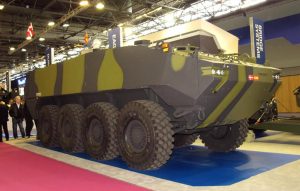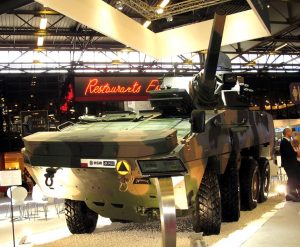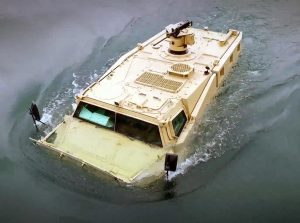Eurosatory 2016: armoured vehicles parade
Paris – Paolo Valpolini
Definitely, more new wheeled vehicles have been unveiled at the 2016 edition of Eurosatory, however, the only one that has really been “unveiled”, having remained under wraps until Day 2 of the exhibition, is part of the tracked family.

We are talking of Rheinmetall’s Lynx, the new infantry fighting vehicle of the German group which, together with Krauss-Maffei Wegmann, manufactures also the German Army new IFV, the Puma, exhibited not far prom the Lynx in the PSM stand. The new IFV maintains some of the features adopted a long time ago on the Marder, such as the rear cooling and rear exhaust system that allow reducing as much as possible the thermal signature. The Lynx features a six road wheels chassis, two different chassis length being available, 7,22 and 7,73 meters, width being 3.6 meters and height 3.3 meters; the shorter version, known as KF 31 (KettenFahrzeugh 31 or tracked vehicle 31) has a maximum GVW of 38 tonnes, the longer one, the KF 41 growing to 42 tonnes and carrying two more dismounts compared to the smaller vehicle that hosts a crew of three plus six infantrymen.
Depending on the weight tracks can be segmented rubber band provided by Diehl Defence, usually less than 30 tonnes, or light weight steel ones, similar to those adopted on the Puma. The KF 31 is powered by a 755 hp engine, providing a 20 hp/t ratio at maximum GVW, the KF 41 being fitted with an engine of over 940 hp, meaning a ratio of over 22 hp/t at 42 tonnes. No details were provided on the armour package, apart the fact that it adopts less exotic solutions than the Puma, air transportability being not an issue on this vehicle.

Rheinmetall having considerable in-house armour knowledge it is safe to say that the packages, tailored to customers needs, will be designed by the company, protection level affecting considerably the vehicle combat weight. The same applies to firepower: the exhibited vehicle, a KF 31 with rubber tracks, was fitted with a Rheinmetall evolved Lance turret armed with a 35 mm gun, fitted with optronics and sensors all from Rheinmetall Defence. It is to note the adoption of a new Spike launcher, which according to some sources should be the one fitted to the turret adopted on the 8×8 Boxer currently bidding for the Land 400 Phase 2 contract in Australia. This country might well be the first target for the Lynx, considering the camouflage scheme adopted: the Army intends starting replacing its M113AS4 in 2025, this being the second step of the Land 400 programme.

As said the Puma was looking closely at its new competitor from the PSM stand, the Bundeswehr being currently receiving its new IFVs, while BAE Systems exhibited in its stand a Combat C2 CV90 at the latest standard adopted by the Norwegian Army. BAE Systems sources told EDR Magazine that the company is in final negotiations with a customer for a version fitted with active protections, while a new customer is looking for active damping suspensions. The latest electronic architecture adopted allows handling NATO Secret communications. Moreover, BAE Systems is working with customers on command and control and sensors issued, UAS being considered to extend situational awareness. Currently, the company is testing the 18 grammes PD-100 Black Hornet rotary wing UAS by Proxdynamics of Norway, while Augmenti AR is providing augmented reality technology.

A Spanish Army’s Pizarro Forward Observer Vehicle was visible at the General Dynamics European Land Systems stand, while FFG of Germany exhibited its G5 and Otokar its Tulpar-S. Talking about armoured tracked vehicles we cannot forget the two main battle tanks, both in the KNDS (KMW Nexter Defence Sytems) stand, the Leclerc, seen with many of the Scorpion improvements, including commanders periscope, turret on turret, and armour, and the Leopard 2 A7V, which is being proposed by KMW to the German Armed Forces.

Said of tracked vehicles, the Parc des Expositions premises at Villepinte was hosting a much greater number of wheeled armoured vehicles. The one with the greater firepower was definitely the Centauro II, exhibited by the Iveco DV – Oto Melara Consortium (CIO), thanks to its 120 mm full pressure gun. Aimed at replacing Italian Army Centauro equipped with a 105 mm gun, it features a semi-automatic loader, carries 31 rounds, and is powered by an Iveco Vector 8V engine.
For more details link to EDR Eurosatory special clicking here. A Freccia fitted with Leonardo-Finmeccanica Sistemi di Difesa (formerly Oto Melara) unmanned turret was also on show, as well as a Freccia Reconnaissance, an evolved version compared to the one seen two years ago in terms of sensors installed.

Iveco DV showed for the first time the latest iteration of its SuperAV, which is that being proposed in team with BAE Systems to the US Marine Corps for the ACV 1.1 programme. A 30 tonnes GVW vehicle with four tonnes payload, it is an enlarged version of the original SuperAV, as it has to host three crew members and 13 dismounts considering the 95 percentile at US standards. Powered by an Iveco Cursor 16 providing 700 hp, the first two axles are steering, the fourth counter-steering axle being provided as an option to reduce the turning circle radius. Powered by two rear propellers, these are fitted with a smaller serrated crown aiming at cutting branches or other entanglements. Iveco DV had built the prototype seen in Paris on company funds to have a demonstrator in Europe and to have also a vehicle identical to the 16 being built in the USA for the USMC testing phase.

The contender to the BAE-Iveco vehicle is the Terrex 2, shortlisted together with the SuperAV. The SAIC-STK team is also engaged in the production of the vehicles required for trials. In Paris, STK unveiled its new Terrex 3, a 35 tonnes vehicle aimed among others at the Australian Land 400 Phase 2 programme. In fact, the vehicle was not exhibited as the prototype was on its way towards Australia fitted with an Elbit Systems unmanned turret.

Another contender aiming at winning down under is the German Boxer exhibited at the Rheinmetall stand in the Dutch engineer configuration and at the KNDS stand fitted with the Puma turret as well as with a Donar artillery module. In the same stand, Nexter was showcasing its VBCI 2, the latest version of the French Army VBCI, fitted with a T40 unmanned turret armed with a 40 mm CTAI gun and MBDA’s MMP missiles.

GDELS was exhibiting its Piranha 5, recently selected by Denmark and Spain, as well as a Piranha 3+, acquired by the Swiss Army in the mortar carrier version, which will be armed with RUAG Defence Cobra 120 mm mortar system. Another indirect fire 8×8 was exhibited at the Polish Huta Stalowa Wola stand in the form of a 120 mm turreted mortar installed over a Rosomak, the Polish version of Patria’s AMV. Another AMV could be seen in the CMI stand, fitted with a Cockerill 3030 turret, while the prototype of the AMV XP was exhibited at the Finnish company stand, together with a part trainer simulation system dedicated to the vehicle fitted with an AMOS mortar turret.


In the 6×6 category, the newest vehicle was not a true one but a mock-up; at the French Army exhibiting area a 1:1 scale model of the Griffon, the APC being developed within the framework of the Scorpion programme, could be seen, other mock-ups being at the KNDS and RTD stands. For detailed info on this vehicle please link to EDR Eurosatory Special clicking here.
Renault Trucks Defence unveiled a series of versions of its VAB Mark 3. The first one was fitted with a CMI Defence CSE 90LP two-man turret, while another was the amphibious version of the Mark 3. The latter is equipped with add-on elements that increase the volume to provide extra buoyancy, and should also add some extra protection against RPGs; in the water, the vehicle is powered by ducted propellers, a trim vane being erected at the front.

The second exhibit for the VAB Electer, the hybrid version of the 6×6; since the 2014 edition of Eurosatory the Electer has been thoroughly tested, seven modes having been validated: “Hybrid” for reduced fuel consumption, “Stealth” for silent running, “Booster” for a quick power boost to accelerate manoeuvres, fast “Recharge” of the traction battery, “APU with battery” enabling silent standby with no onboard generators, “APU with combustion engine” offering high-level electric power, and “Diesel”, for travelling in fallback mode. A hybrid power pack might be proposed for the Jaguar reconnaissance vehicle part of the Scorpion programme, although this might be considered for a vehicle update and not adopted from the beginning.

The Streit Group unveiled its Alligator 6×6; a Level 4 protected vehicle, both ballistic and mines, it hosts two crew members plus eight dismounts and is powered by a Cummins ISL 400 engine providing 400 hp.

Coming to lighter vehicles, Iveco DV unveiled its LMV 2, a quantum jump compared to the original LMV and previous evolutions. With an 8.1 tonnes combat weight, it has a 1.500 kg payload, a 40% increase compared to the latest versions of the Italian 4×4. It is powered by a 220 hp engine and is fitted with an automatic drive management system that assists the driver on difficult terrains. or detailed info on this vehicle please link to EDR Eurosatory special clicking here.
First appearance at Eurosatory for the Joint Light Tactical Vehicle, the Oshkosh Defense 4×4 that will partly replace HMMWVs in US Army and Marines inventories. Fitted with a Kongsberg CROWS II weapon station it will provide a much higher protection to patrols compared to the up-armoured Humvees.

The RTD Sherpa was visible in different forms, one of them in the GIGN colours, showing its flexibility in serving both military and paramilitary forces. It is impossible to name all the 4×4 armoured vehicles present on the Eurosatory premises, a few add-on pictures providing some impression to our readers.






